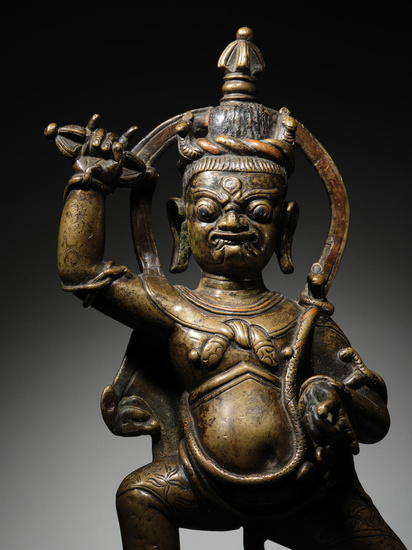A SILVER AND COPPER INLAID COPPER ALLOY FIGURE OF VAJRAPANI...
A SILVER AND COPPER INLAID COPPER ALLOY FIGURE OF VAJRAPANI
TIBET, 13TH CENTURY
Himalayan Art Resources item no. 2127
16.2 cm (6 3/8 in.) high
西藏 十三世紀 錯銀錯紅銅金剛手菩薩銅像
This eccentric sculpture of the protector deity Vajrapani exhibits the life and vigor of early Tibetan art. His fierce qualities are exaggerated with a spirited naiveté, conveying his ability to subdue any harmful phenomena that would threaten the dharma and its practitioners.
His three eyes are spread disproportionately apart, bulging with silver globules encircled by copper rims. The wrinkles of his furrowed brow form thick bands above the bridge of his nose, while he bites his lower lip in a seething rage to reveal silver-inlaid fangs. Rarely seen, the caster also employs copper inlay to delineate the underbelly of the snake that coils around its own body to hang over Vajrapani's large stomach. It distinguishes the entwined lengths of two more snakes which form a crown above his head. Unlike the snakes that adorn his arms and legs, these three in particular appear crowned with small diadems, a nod to the serpent kings (nagarajas) of ancient Indic lore.
Compared to most depictions of Vajrapani, the snakes, the animal skins wrapped around his chest and haunches, and the prominent vajra surmounting from his chignon towards the heavens, are the deity's only adornments; he is not encumbered by the typical crowns and jeweled trappings that blend connotations of worldly power and wealth with spiritual authority. In this manner, the sculpture breaks from the legacies of Indian art and suggests a date shortly after the period of Tibet's great apprenticeship of Indian Buddhism (10th-12th centuries). It indicates the work of a bronze caster who is not simply copying a prototype, but engaging freshly with the teachings and the spirit of the deity and interpreting them visually in a creative and spontaneous way.
Published
David Weldon and Jane Casey Singer, The Sculptural Heritage of Tibet: Buddhist Art in the Nyingjei Lam Collection, London, 1999, pp. 57-9, fig. 23.
Franco Ricca, Arte Buddhista Tibetana: Dei e Demoni dell'Himalaya, Turin, 2004, no. 36.
The Light of the Buddha: Buddhist Sculptures of the Palace Museum and Zhiguan Museum of Fine Art, Beijing, 2019, pp. 292-5, no. 75.
Exhibited
The Sculptural Heritage of Tibet, Ashmolean Museum, Oxford, 6 October–30 December 1999
Arte Buddhista Tibetana: Dei e Demoni dell'Himalaya, Turin, Palazzo Bricherasio, 18 June–19 September 2004
Casting the Divine: Sculptures from Nyingjei Lam Collection, Rubin Museum of Art, New York, 2 March 2012–11 February 2013
The Light of the Buddha: Buddhist Sculptures of the Palace Museum and Zhiguan Museum of Fine Art, Beijing, 23 October – 23 December 2018
Provenance
Nyingjei Lam Collection
On loan to the Ashmolean Museum, Oxford, 1996–2005
On loan to the Rubin Museum of Art, New York, 2005–2019
Bonhams, Hong Kong, 29 November 2016, lot 115
A Distinguished Asian Collector
View it on
Estimate
Time, Location
Auction House
A SILVER AND COPPER INLAID COPPER ALLOY FIGURE OF VAJRAPANI
TIBET, 13TH CENTURY
Himalayan Art Resources item no. 2127
16.2 cm (6 3/8 in.) high
西藏 十三世紀 錯銀錯紅銅金剛手菩薩銅像
This eccentric sculpture of the protector deity Vajrapani exhibits the life and vigor of early Tibetan art. His fierce qualities are exaggerated with a spirited naiveté, conveying his ability to subdue any harmful phenomena that would threaten the dharma and its practitioners.
His three eyes are spread disproportionately apart, bulging with silver globules encircled by copper rims. The wrinkles of his furrowed brow form thick bands above the bridge of his nose, while he bites his lower lip in a seething rage to reveal silver-inlaid fangs. Rarely seen, the caster also employs copper inlay to delineate the underbelly of the snake that coils around its own body to hang over Vajrapani's large stomach. It distinguishes the entwined lengths of two more snakes which form a crown above his head. Unlike the snakes that adorn his arms and legs, these three in particular appear crowned with small diadems, a nod to the serpent kings (nagarajas) of ancient Indic lore.
Compared to most depictions of Vajrapani, the snakes, the animal skins wrapped around his chest and haunches, and the prominent vajra surmounting from his chignon towards the heavens, are the deity's only adornments; he is not encumbered by the typical crowns and jeweled trappings that blend connotations of worldly power and wealth with spiritual authority. In this manner, the sculpture breaks from the legacies of Indian art and suggests a date shortly after the period of Tibet's great apprenticeship of Indian Buddhism (10th-12th centuries). It indicates the work of a bronze caster who is not simply copying a prototype, but engaging freshly with the teachings and the spirit of the deity and interpreting them visually in a creative and spontaneous way.
Published
David Weldon and Jane Casey Singer, The Sculptural Heritage of Tibet: Buddhist Art in the Nyingjei Lam Collection, London, 1999, pp. 57-9, fig. 23.
Franco Ricca, Arte Buddhista Tibetana: Dei e Demoni dell'Himalaya, Turin, 2004, no. 36.
The Light of the Buddha: Buddhist Sculptures of the Palace Museum and Zhiguan Museum of Fine Art, Beijing, 2019, pp. 292-5, no. 75.
Exhibited
The Sculptural Heritage of Tibet, Ashmolean Museum, Oxford, 6 October–30 December 1999
Arte Buddhista Tibetana: Dei e Demoni dell'Himalaya, Turin, Palazzo Bricherasio, 18 June–19 September 2004
Casting the Divine: Sculptures from Nyingjei Lam Collection, Rubin Museum of Art, New York, 2 March 2012–11 February 2013
The Light of the Buddha: Buddhist Sculptures of the Palace Museum and Zhiguan Museum of Fine Art, Beijing, 23 October – 23 December 2018
Provenance
Nyingjei Lam Collection
On loan to the Ashmolean Museum, Oxford, 1996–2005
On loan to the Rubin Museum of Art, New York, 2005–2019
Bonhams, Hong Kong, 29 November 2016, lot 115
A Distinguished Asian Collector



